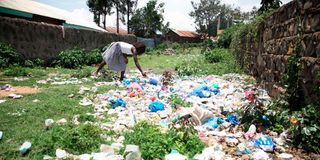Tackling Kisumu’s waste crisis with innovation

Used diapers disposed of at the backyard of a residential estate in Nyalenda slums, Kisumu County.
What you need to know:
- A technology that enables the tracking and tracing of waste , including diapers and plastics, from source to disposal site, is promising to end the menace.
- The blockchain technology provides a secure and transparent platform for recording every step in the waste management lifecycle, from waste generation to collection, transportation, recycling or disposal, ensuring that it is disposed of in a responsible and environmentally friendly manner.
For years, Donna Atieno, a resident of Nyalenda slums in Kisumu, has been disposing of used diapers by the roadside or in open dumping sites.
This, she says, is a decision she arrived at after her landlord, tired of emptying their rental apartment’s pit latrine, asked women with newborns to find an alternative dumping site.
Disposable diapers contain absorbent chemicals and are thrown away after use, remaining un-biodegraded in the disposal sites.
“Apart from filling up the pit latrines fast, the landlord shared his concerns that the diapers do not decompose easily, thus posing a challenge in the slums ,” says Ms Atieno.
She adds: “Initially, we had been advised to burn the diapers using paraffin but considering the high cost of living and the fact that diapers do not burn completely posed yet another challenge. “
Ms Atieno and other new mothers in the slums therefore resorted to dumping the diapers by the roadside under the cover of darkness. She discloses that sometimes she sends her 12-year-old son to throw them in a nearby stream.
The diapers are washed downstream and end up in Lake Victoria, where they pose a threat to aquatic life.
But there is good news. A technology that enables the tracking and tracing of waste , including diapers and plastics, from source to disposal site, is promising to end the menace.
The blockchain technology provides a secure and transparent platform for recording every step in the waste management lifecycle, from waste generation to collection, transportation, recycling or disposal, ensuring that it is disposed of in a responsible and environmentally friendly manner.
Researchers from Jaramogi Oginga Odinga University of Science and Technology, Victoria Institute for Research on Environment and Development (VIRED), a local non-governmental organisation, joined forces with the University of Ghana and the United Kingdom’s University of Southampton to find a permanent solution to the crisis.
The project funded by UK Research and Innovation collective fund aims at minimising entry of unmanaged plastics into the environment.
According to a national survey conducted by the four institutions, more than a quarter of Kenyan households with children of diaper-wearing age buy the commodities yet a majority lack proper disposal facilities.
The survey highlights the alarming threat posed by mismanaged waste to water sources as well as the associated health risks.
The study dubbed ‘Expanding Safe Water and Waste Management Service Access to Off-Grid Urban Populations in Africa’ was conducted in Kisumu, Ghana and the United Kingdom.
“The survey established the difficult trade-off between sanitation access for urban households, waste management and the need for manufacturers, waste and sanitation specialists to think creatively about short and long-term solutions to this rapidly emerging environmental and public health issue,” said Prof Jim Wright, the research project coordinator.
Mr Joseph Okotto-Okotto, the project’s lead researcher at VIRED International, said that during the survey, the researchers looked at coverage of Google’s Street View imagery around Kisumu.
The research team also created a mobile application which was used by locals to report cases of unauthorised dumping of waste.
Mr Okotto added that they utilised blockchain technology to monitor waste throughout its life cycle to minimise risk of improper dumping.
The team found that while waste features were visible on Google Street View imagery, there was more waste burning happening in back streets, which are not covered by such imagery.
“Monitoring waste with tools like household surveys or Google Street View could help in targeting waste hotspots. They could also help in lobbying for manufacturer investment in solutions for handling the waste streams generated by their products such as separate bins for used diapers or more reusable diaper designs ,” he said.
He stressed the need to help new mothers to manage diaper waste with the aim of increasing sanitation access and tackling p




